Ken MacLeod's Blog, page 11
June 14, 2013
Iain M. Banks (1954 - 2013)
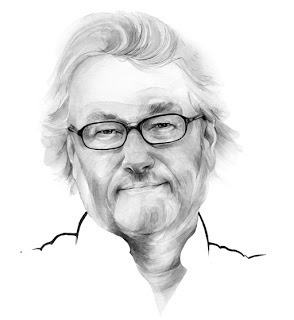 [Image: Kate Copeland,
The Skinny
]
[Image: Kate Copeland,
The Skinny
]Iain Banks died last Sunday. I have lost my oldest friend. I was asked to speak about him for radio and TV, and I have. I was asked to write about his SF, and I did. I've tried to write something more personal, and I've failed.
Here are a few lines I wrote some years ago, for an introduction to a German edition of Consider Phlebas. It outlines an outlook implied in the Culture books.
To live a human life is to die. Immortality is for gods. Humans can become gods, but to do so is to cease to be human, and that too is a kind of death. In accepting mortality the humans have the chance, their only chance, to make their lives complete, sufficient, shaped; and to get out of the game while they're ahead.
This is what gives the book, with all its violence, its fundamental gaiety. Life may be a game of damage, but it is a game to be played with grace, every day new under the sun.
Iain did that.
Published on June 14, 2013 02:14
June 1, 2013
Impending Manifestations
 I have two public events coming up, this month and next.
I have two public events coming up, this month and next.First, there's the Futura Sci-Fi Convention, a one-day event on Saturday 15 June in Wolverhampton's innovative arts centre the Light House. My fellow guests of honour are Adam Roberts and Ian R. MacLeod, so I feel honoured indeed, and I'm very much looking forward to it. The day and evening event has all the usual features of an SF convention: panels, GoH readings, kaffeeklatches, signing sessions, book stalls, a real ale bar etc, without the hassle of hotels and all for a modest £25 (or £100 for a group of five). Details and bookings here.

My second upcoming public event is in July. Napier MA Creative Writing student Anni Telford has made canny use of her contacts to set up a series of workshops for writers featuring three-quarters of the Napier MA Creative Writing course team. Stuart Kelly talks about writing creative non-fiction next Friday (7 June). I'll be talking about writing SF and fantasy on Friday 5 July. David Bishop will teach the dark arts of writing graphic novels on Tuesday 23 July. Full details and bookings here and the same with a downloadable flyer from the group putting on the workshops, the Booktown Writers.
Published on June 01, 2013 07:58
May 27, 2013
Napier Creative Writing Open Doors Event
The MA Creative Writing course at Edinburgh Napier University is holding a free (but ticketed) Open Doors event tomorrow evening (Tuesday 28th May).
Here's the schedule for Open Doors 2013:
5.30 Arrive for tea and coffee6.00 Introduction to MA Creative Writing at Edinburgh Napier6.20 Taster session: writing for graphic fiction with David Bishop7.00 Taster session: experimental writing with Sam Kelly7.45 Q & A with staff and current students8.15 Drinks8.30 Reading by Ken MacLeod, writer-in-residence9.00 Close
Full details and a link to booking here.
Here's the schedule for Open Doors 2013:
5.30 Arrive for tea and coffee6.00 Introduction to MA Creative Writing at Edinburgh Napier6.20 Taster session: writing for graphic fiction with David Bishop7.00 Taster session: experimental writing with Sam Kelly7.45 Q & A with staff and current students8.15 Drinks8.30 Reading by Ken MacLeod, writer-in-residence9.00 Close
Full details and a link to booking here.
Published on May 27, 2013 07:19
April 19, 2013
Rockets for Edwin Morgan
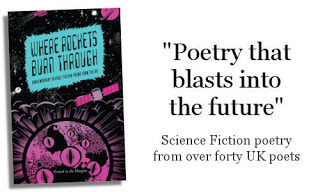
Next Thursday, 25 April at 6.30 pm. the Scottish Poetry Library hosts live readings from the highly successful SF poetry anthology Where Rockets Burn Through, edited by Russell Jones.
This event will also include a short movie by Dan Warren based on Edwin Morgan's SF poem, ‘In Sobieski's Shield’. The event will feature the following poets:
Ron Butlin
Pippa Goldschmidt
Andy Jackson
Kelley Swain
Claire Askew
Ian McLachlan
Date25 April 2013 - 6:30pmLocationScottish Poetry Library, 5 Crichton's Close, Canongate, EdinburghPrice£7/£5
Details and bookings here.
Published on April 19, 2013 06:28
April 17, 2013
The Writing Front
Yesterday I completed a first draft of my new novel, provisonally titled Descent. The feel and tone of Descent is about as unskiffy as I could make it. My pitch to myself for
Intrusion
was 'genomics Aga Saga'. The equivalent marching song for Descent was 'near-future bloke-lit'.
Bloke-lit's the kind of book Nick Hornby and Tony Parsons do so well: a first-person, confessional tale of an ordinary guy who behaves with typical male insensitivity and self-absorption until at least one exasperated woman-in-his-life knocks him about the head with some home truths. In Descent the narrator's excuse for being such a dick is that in his teens he got knocked on the head by a flying saucer. Also, he suspects the revolution may have happened while he was studying for his final high school exams. When his girlfriend tells him he and she may be from different human species, relationships become strained. We've all been there.
There's no doubt more to be done with it but the feeling of a weight off my shoulders is dizzying. I intend to make very sure my next novel is outlined in far more detail before I start writing -- but then, I always say that.
So, on to stuff I've been neglecting for the past few weeks:
First, as many of you know, Intrusion has been shortlistedfor the Arthur C. Clarke Award. I am of course delighted. This year's shortlist has caused some controversy, which has raised the award's mainstream profile. The book's latest enthusiastic review is in the LA Review of Books (which seems to have a rather Clutean policy of not worrying about spoilers, so be warned).
Second, Intrusion didn't win the BSFA Award for best novel -- Adam Roberts' Jack Glass did, for which belated congratulations.
Third, my novella The Human Front is now out in a new US edition from PM Press, with supplementary material, and very good it looks too. If you want a signed (and personalised, if you like) copy of this nifty paperback, you can order/reserve one at Edinburgh's great SF bookshop Transreal. An ebook version is available here.
Bloke-lit's the kind of book Nick Hornby and Tony Parsons do so well: a first-person, confessional tale of an ordinary guy who behaves with typical male insensitivity and self-absorption until at least one exasperated woman-in-his-life knocks him about the head with some home truths. In Descent the narrator's excuse for being such a dick is that in his teens he got knocked on the head by a flying saucer. Also, he suspects the revolution may have happened while he was studying for his final high school exams. When his girlfriend tells him he and she may be from different human species, relationships become strained. We've all been there.
There's no doubt more to be done with it but the feeling of a weight off my shoulders is dizzying. I intend to make very sure my next novel is outlined in far more detail before I start writing -- but then, I always say that.
So, on to stuff I've been neglecting for the past few weeks:
First, as many of you know, Intrusion has been shortlistedfor the Arthur C. Clarke Award. I am of course delighted. This year's shortlist has caused some controversy, which has raised the award's mainstream profile. The book's latest enthusiastic review is in the LA Review of Books (which seems to have a rather Clutean policy of not worrying about spoilers, so be warned).
Second, Intrusion didn't win the BSFA Award for best novel -- Adam Roberts' Jack Glass did, for which belated congratulations.
Third, my novella The Human Front is now out in a new US edition from PM Press, with supplementary material, and very good it looks too. If you want a signed (and personalised, if you like) copy of this nifty paperback, you can order/reserve one at Edinburgh's great SF bookshop Transreal. An ebook version is available here.
Published on April 17, 2013 05:10
April 16, 2013
Stem Cell Stories - creative non-fiction competition
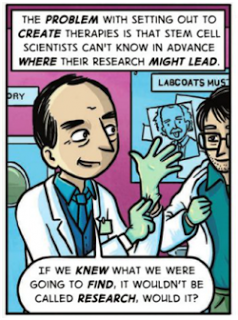 We all have stem cells in us -- but do you have a stem cell story in you?
We all have stem cells in us -- but do you have a stem cell story in you?A non-fiction story, that is; or a poem; or four to six pages of graphic non-fiction? If so, and if you're not a professionally published writer, this exciting competion sponsored by EuroStemCell could be your big chance.
We're looking for imaginative science writing, fresh and original, accurate and relevant, on the theme of stem cells and regenerative medicine, and accessible to a non-specialist audience.
Fame (your work published worldwide online) and fortune (300 euros first prize, 50 euros each for two runners-up) await. That's got to be worth a few hours of anybody's time. So take a look, read the criteria and the terms and conditions carefully, and give it a go.
Published on April 16, 2013 08:57
April 4, 2013
Against a Dark Background
As the world now knows, Iain Banks has cancer and the prognosis is not good. Yesterday he made the grim news public with characteristic courage and wit, having done the same privately some weeks ago. He and I have been very close friends for about forty years. Nobody could have a better friend.
Iain has given me enormous support and encouragement over these four decades. He read and critiqued early drafts of my first novel, and gave it a great boost with a generous cover quote. In recent years we've taken to talking over rather than reading each other's works in progress. For me at least that has been an irreplaceable part of the process of writing. Reading his books is a delight in itself, and a permanent inspiration to try harder. His work has had the same effect on SF as a whole: an open invitation to raise the game and an example of how to do it.
Iain, it has suddenly and terribly become clear, is one of those authors who is not only popular but loved, and whose work has become a part of how many of his readers think and feel about the world. The outpouring of tributes has been almost unbearably moving.
A website has been set up for family and fans to leave messages and check on his progress. Go there, now.
Iain has given me enormous support and encouragement over these four decades. He read and critiqued early drafts of my first novel, and gave it a great boost with a generous cover quote. In recent years we've taken to talking over rather than reading each other's works in progress. For me at least that has been an irreplaceable part of the process of writing. Reading his books is a delight in itself, and a permanent inspiration to try harder. His work has had the same effect on SF as a whole: an open invitation to raise the game and an example of how to do it.
Iain, it has suddenly and terribly become clear, is one of those authors who is not only popular but loved, and whose work has become a part of how many of his readers think and feel about the world. The outpouring of tributes has been almost unbearably moving.
A website has been set up for family and fans to leave messages and check on his progress. Go there, now.
Published on April 04, 2013 04:19
April 2, 2013
You Can See the Comet
... if you live in the northern hemisphere, anyway. I saw it from my doorstep last night, through the glare of nearby street lamps, using 8x40 binoculars and this map from @VirtualAstro. (Click to enlarge; follow @VirtualAstro or your local equivalent outside the UK for #PanSTARRS updates.)
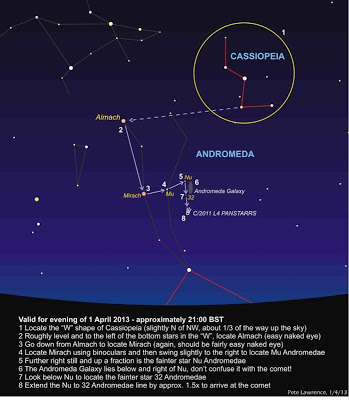

Published on April 02, 2013 22:52
March 19, 2013
A better distillation
Update: A much more comprehensive account, with splendidly evocative pics, of the symposium I wrote about below is here.
Published on March 19, 2013 03:20
The Evaporation of Things, distilled
Social science has a permanent problem of identifying its objects of study. The relationships, interactions, institutions, organizations and other aspects of society may have all sorts of things connected with them that we can see and touch, such as houses and police stations and pound coins and wedding rings, but the relationships themselves they aren't stuff you can spot on CCTV. Identifying new or hitherto unnoticed goings-on between people or in their minds or in how they relate to the world around them is always going to be tricky and contestable. Is such-and-such a one-off, a will-o-the-wisp, or is it, as the fashion columnists would say, a thing? (This usage of 'a thing' has definitely become a thing.)
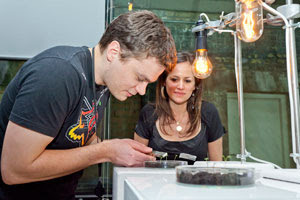 Artists, at least the kind of artists who cause outrage and bafflement when their work is exhibited in the Tate, have a similar problem. You want your work to glom onto something significant and say something about it that makes sense to yourself if to no one else, and you're allowed to do that with any material at all within the law and health and safety regulations: bits of tin, wire, plaster of Paris, marble, bronze, paint, canvas, neon tubes, dust bunnies, pickled shark... If you're very clever and /or lucky, you might hit on exactly the right expression for some feeling or situation or condition that no one has quite put their finger on before. Fame, fortune, and an angry editorial in the Daily Mail await.
Artists, at least the kind of artists who cause outrage and bafflement when their work is exhibited in the Tate, have a similar problem. You want your work to glom onto something significant and say something about it that makes sense to yourself if to no one else, and you're allowed to do that with any material at all within the law and health and safety regulations: bits of tin, wire, plaster of Paris, marble, bronze, paint, canvas, neon tubes, dust bunnies, pickled shark... If you're very clever and /or lucky, you might hit on exactly the right expression for some feeling or situation or condition that no one has quite put their finger on before. Fame, fortune, and an angry editorial in the Daily Mail await.
So there they are, social scientists and artists, looking about, antennae quivering, alert for the new. Might they sometimes help each other lock onto the same scent?
Last week I attended a symposium at Inspace, the arts venue of Edinburgh University's Informatics Department. The space is functionally divided between an auditorium and a gallery, and is so modern it aches -- literally enough after a while, as the audience sits on thin cushions scattered along steps. The event, initiated by the Genomics Forum, brought together social scientists, natural scientists, and artists. I was there to blog the event's first day; Pat Kane, currently a visiting fellow at the Forum, would cover the second. The question the symposium asks, I suppose, is: 'Is the question "Where is the thing?" becoming a thing?' Its hashtag is #eot13. Its rubric:
Maria's co-organiser Chris Speed of the College of Art kicked off with a clip of the Challenger disaster, with its familiar voice-over of a man reading from the space shuttle's instruments and continuing to relay numbers for several seconds after the rest of America had watched the craft explode live on television. That shocked moment of delayed realisation when someone tapped the announcer's shoulder and pointed to the TV screen was, Chris said, what this symposium was about. He gave other examples: the debris of the later space shuttle crash, Columbia, tagged, connected by strips of tape, and spread across across a floor as a physical database; the flash crash of May 6 2010, as two duelling algorithms dumped stocks in a death spiral only interrupted by physically pulling the plugs; and one of his students' art projects, which consisted of a thick stack of A4, a printout of reports from her iPhone for one day.
The presentations that followed were intriguing, varied, and of high quality. Mike Phillips took us from the melting Wicked Witch to the unease-inducing ambiguities of how scientific imaging converts numbers to visuals. Synthetic biologist Vincent Danos took us ever deeper into the molecular structure of starch and the phenomenology of mathematical modelling. Laura Beloff charmed and delighted with her sci-art projects, starting with a portable 'space station for fruit flies'. Sociologist Gill Haddow walked us through how 'human' became in some contexts legally defined in terms of percentages of DNA.

After and over drinks in the early evening, the exhibiting artists displayed and discussed their work. I wouldn't presume to judge or compare -- take a look for yourself -- but for me by far the most memorable and disturbing of their artefacts was Ai Hasegawa's short film of a woman giving birth to a salmon, which she later eats. Sushi will never be the same.
So was the symposium a success? Did the artists, scientists, and sociologists combine their particular points of view to outline, somewhere in the room, an elephant we'd have otherwise missed? I think they did. The evaporation of things is a thing.
 Artists, at least the kind of artists who cause outrage and bafflement when their work is exhibited in the Tate, have a similar problem. You want your work to glom onto something significant and say something about it that makes sense to yourself if to no one else, and you're allowed to do that with any material at all within the law and health and safety regulations: bits of tin, wire, plaster of Paris, marble, bronze, paint, canvas, neon tubes, dust bunnies, pickled shark... If you're very clever and /or lucky, you might hit on exactly the right expression for some feeling or situation or condition that no one has quite put their finger on before. Fame, fortune, and an angry editorial in the Daily Mail await.
Artists, at least the kind of artists who cause outrage and bafflement when their work is exhibited in the Tate, have a similar problem. You want your work to glom onto something significant and say something about it that makes sense to yourself if to no one else, and you're allowed to do that with any material at all within the law and health and safety regulations: bits of tin, wire, plaster of Paris, marble, bronze, paint, canvas, neon tubes, dust bunnies, pickled shark... If you're very clever and /or lucky, you might hit on exactly the right expression for some feeling or situation or condition that no one has quite put their finger on before. Fame, fortune, and an angry editorial in the Daily Mail await.So there they are, social scientists and artists, looking about, antennae quivering, alert for the new. Might they sometimes help each other lock onto the same scent?
Last week I attended a symposium at Inspace, the arts venue of Edinburgh University's Informatics Department. The space is functionally divided between an auditorium and a gallery, and is so modern it aches -- literally enough after a while, as the audience sits on thin cushions scattered along steps. The event, initiated by the Genomics Forum, brought together social scientists, natural scientists, and artists. I was there to blog the event's first day; Pat Kane, currently a visiting fellow at the Forum, would cover the second. The question the symposium asks, I suppose, is: 'Is the question "Where is the thing?" becoming a thing?' Its hashtag is #eot13. Its rubric:
The symposium Evaporation of Things is intended to explore the increasingly digital interface to biological ‘things’. From the phylogenetic analysis of plants, to the data representation of the human genome project, studying the subject on a screen has replaced the study of the material artefact. For the general public, astronomy remains a question of looking at the stars in the night sky, whereas for astronomers the use of optical telescopes is a thing of the past – so the question emerges “where is the thing?”Forum Director
The natural sciences have been prolific in practising not only this evaporation of things but also in reassembling innovative living entities, such as genetically modified organisms, and new creative possibilities are emerging with the advent of the enhancement of the human body with cybertechnologies. This fluidity of the living things is potentiated by interdisciplinary engagements, and entities which are in one minute the subjects of sciences become in the next the raw materials for arts.
Maria's co-organiser Chris Speed of the College of Art kicked off with a clip of the Challenger disaster, with its familiar voice-over of a man reading from the space shuttle's instruments and continuing to relay numbers for several seconds after the rest of America had watched the craft explode live on television. That shocked moment of delayed realisation when someone tapped the announcer's shoulder and pointed to the TV screen was, Chris said, what this symposium was about. He gave other examples: the debris of the later space shuttle crash, Columbia, tagged, connected by strips of tape, and spread across across a floor as a physical database; the flash crash of May 6 2010, as two duelling algorithms dumped stocks in a death spiral only interrupted by physically pulling the plugs; and one of his students' art projects, which consisted of a thick stack of A4, a printout of reports from her iPhone for one day.
The presentations that followed were intriguing, varied, and of high quality. Mike Phillips took us from the melting Wicked Witch to the unease-inducing ambiguities of how scientific imaging converts numbers to visuals. Synthetic biologist Vincent Danos took us ever deeper into the molecular structure of starch and the phenomenology of mathematical modelling. Laura Beloff charmed and delighted with her sci-art projects, starting with a portable 'space station for fruit flies'. Sociologist Gill Haddow walked us through how 'human' became in some contexts legally defined in terms of percentages of DNA.

After and over drinks in the early evening, the exhibiting artists displayed and discussed their work. I wouldn't presume to judge or compare -- take a look for yourself -- but for me by far the most memorable and disturbing of their artefacts was Ai Hasegawa's short film of a woman giving birth to a salmon, which she later eats. Sushi will never be the same.
So was the symposium a success? Did the artists, scientists, and sociologists combine their particular points of view to outline, somewhere in the room, an elephant we'd have otherwise missed? I think they did. The evaporation of things is a thing.
Published on March 19, 2013 02:04
Ken MacLeod's Blog
- Ken MacLeod's profile
- 762 followers
Ken MacLeod isn't a Goodreads Author
(yet),
but they
do have a blog,
so here are some recent posts imported from
their feed.



